Notifications
ALL BUSINESS
COMIDA
DIRECTORIES
ENTERTAINMENT
FINER THINGS
HEALTH
MARKETPLACE
MEMBER's ONLY
MONEY MATTER$
MOTIVATIONAL
NEWS & WEATHER
TECHNOLOGIA
TV NETWORKS
VIDEOS
VOTE USA 2026/2028
INVESTOR RELATIONS
DEV FOR 2025 / 2026
ALL BUSINESS
COMIDA
DIRECTORIES
ENTERTAINMENT
FINER THINGS
HEALTH
MARKETPLACE
MEMBER's ONLY
MONEY MATTER$
MOTIVATIONAL
NEWS & WEATHER
TECHNOLOGIA
TV NETWORKS
VIDEOS
VOTE USA 2026/2028
INVESTOR RELATIONS
DEV FOR 2025 / 2026
About Me
 Latinos Media
Latinos Media Latinos Media provides all types of news feeds on a daily basis to our Members
Posted by - Latinos Media -
on - October 31, 2023 -
Filed in - Marketing -
-
547 Views - 0 Comments - 0 Likes - 0 Reviews

If it’s your first time using ChatGPT, your answers may sound stilted. The program doesn’t know your voice and is trying to learn what you want. If you want to get the best results, you’ll need to invest time in training the algorithm.
Think of ChatGPT like an intern. If it’s their first day, they won’t know exactly how to get the job done. However, with practice and clear instructions, you’ll be amazed by what they can accomplish.
Our guide on how to train ChatGPT will give you a step-by-step breakdown to customize ChatGPT based on your specific needs. In this article, we’ll show you how to turn ChatGPT into your personal marketing assistant with:
When ChatGPT first came into the spotlight, people asked it to write songs and solve complex mathematical questions.
Now, with a premium plan and hundreds of plugins to expand the tool’s capabilities, marketers have realized ChatGPT’s potential to become a high-functioning assistant to make life easy.
We found the top five marketing use cases you can explore (and prompts to use):
1. In-Depth Market ResearchYou can use ChatGPT to explore any industry or vertical in detail.
It’ll give you a clearer understanding of your competitors, target audience, and location-specific nuances.
The tool can study publicly available information and find granular insights about the market — demographics to target, buyer preferences, competitor landscape, and other useful details.
This can be a good starting point for creating a marketing strategy from scratch.
Prompt: I want to start an ecommerce store selling hand-made jewelry and accessories created from sustainable materials in Austin, Texas. Act as a market researcher and give me information on the demographics of people most likely to order these products in Austin — including age groups, income, education, gender, and specific location.
All successful marketing campaigns have one thing in common: listening to customers.
You have to stay on top of customer expectations and preferences when planning or reviewing your marketing efforts.
ChatGPT can simplify this process.
You can get a pulse on your customers with surveys created using ChatGPT. You can also be more specific to get clear, on-point questions to be added to surveys.
You can add specific instructions about the type of questions to include, like multiple-choice, rating-based, etc.
Prompt: I run an agency to help businesses create + edit video content in multiple formats. Create a customer survey to help me collect their feedback once I complete a project. Write 10-12 objective, close-ended questions asking about their satisfaction levels. Add one subjective question for their overall feedback.
Using ChatGPT to make outlines for blog content is another great way to fast-track your marketing workflows.
You can create a template prompt with all the instructions for creating detailed outlines and use it whenever you want to write an article.
Not only that, once you’re done writing the content, you can also feed your draft to ChatGPT for proofreading. You can ask the tool to pinpoint errors and share language suggestions based on your defined tone of voice.
Prompt: Create a detailed outline on the topic “Customer marketing for SaaS” following the BLUF approach. Add a compelling title and include bullet points within each section to explain what to include in these sections. Write the headings in sentence case and use H3s and H4s wherever needed. Properly format this outline.
Don’t have the time to create some juicy copy for your next social media post? Or are you spending way too much time coming up with a good subject line for your emails?
You can use ChatGPT as your creative sidekick to write short-form copy and content in seconds.
Instead of wrecking your head thinking about the best copy, create a detailed prompt to let ChatGPT do the heavy lifting quickly.
Prompt: Create an email for our existing customers to introduce our latest feature, AI voiceover. This feature will let them add AI-generated audio in different voices, styles, and languages. They can download and transcribe this audio as well. Highlight our motivations for creating this feature and end with a CTA gently nudging them to try it.
TOV: Keep it friendly, conversational, and exciting.
You can go a notch above this to plan an entire campaign with HubSpot’s Campaign Assistant. The tool can help you plan and execute marketing campaigns from start to finish without the busywork.
Get Started With HubSpot’s Campaign Assistant
5. Repurposing Content for Different ChannelsCreate once, repurpose forever — that’s the mantra for most marketers these days.
But let’s face it, many marketers drop the ball here because repurposing content can be a pain. It takes too much time, and workflows are usually complicated.
You can cut all this hassle with ChatGPT. You can convert:
The possibilities are endless.
You can also use ChatSpot, HubSpot’s AI-powered companion, to outline, draft, rewrite and repurpose content, create social media posts, generate images based on prompts, and more.
Get Started With HubSpot’s ChatSpot
ChatGPT for Marketing: Key Advantages and Limitations to KnowWhen used well, ChatGPT can truly be a game-changer for marketers. But it’s not without its flaws. Let’s look at ChatGPT’s main benefits and shortcomings.
Advantages of ChatGPT in MarketingHere are a few major benefits of integrating ChatGPT into your marketing workflow:
1. Speed Up CreativityOne of the biggest wins ChatGPT gives marketers is driving efficiency in creative work.
Whether you’re planning a new campaign or writing some copy, you don’t have to spend hours to come up with just a handful of good ideas.
ChatGPT can flex those creative muscles for you and get the job done quickly.
2. Cost-Effective AssistantThe free version of the tool works pretty great for the most part. But if you want to level up and produce even better output at scale, you can upgrade at just $20 a month.
That’s a bargain when you think of all the work you can do in minutes.
3. Round-the-Clock AvailabilityAnother huge benefit is that ChatGPT works on your time and terms.
Whether you’re an early riser or a night owl, working on a Monday or the weekend, the tool is available round-the-clock to support your work with the same quality of output.
4. Ease of Integration With Other ToolsYou can also integrate ChatGPT with any tool using its API.
Add it to your website chatbot or inside your app; you can use it for any task to maximize efficiency. For example, you can use it to collect and qualify leads from your website or create emails in minutes.
Limitations of ChatGPT in MarketingChatGPT might not be ideal for some use cases; here’s why.
1. Prone to Poor Quality and Inaccurate OutputUsers share the concern that the tool sometimes throws up low-quality and incorrect responses.
An article by the SF Chronicle explained how LLMs can generate false information based on training data without knowing real-world facts.
Here’s an example of inaccurate outputs by different AI models:
ChatGPT also lacks the ability to understand and retain information based on context. That means you have to feed it the same instructions every time you want to prompt an output.
Its LLMs also develop biases present in the training data. So, the context of your output is not fully objective.
3. No Knowledge of Brand IdentityUnlike humans in your team, ChatGPT can’t develop an in-depth knowledge of your brand.
You must continuously share relevant details of your brand identity and values whenever you want to generate any output.
This often results in subpar results and is not fully aligned with your brand.
4. Technical GlitchesA fairly common issue with ChatGPT is the frequent outages when the tool becomes completely inoperative. These unanticipated glitches can hamper your productivity and throw you off schedule.
5 Actionable Tips for Training ChatGPT for MarketingNow that we’ve covered the basics of how you can use ChatGPT for marketing, it’s time to get down to business: how to train ChatGPT.
While there are tons of marketing examples to inspire your training efforts, we’ve curated our top five tips for training the tool for customized outputs.
1. Document your brand guidelines.Help ChatGPT understand your brand inside out with detailed brand guidelines.
This document should ideally include your vision, mission, values, personality characteristics, tone of voice, and visual elements.
You can input these guidelines in the Custom Instructions feature to align all your responses with these instructions.
The tool also gives you a few questions to answer to make these instructions work more effectively.
Another best practice is to create templated instructions for every use case — whether you want to create a weekly newsletter, find ideas for social media, or make blog outlines.
These templates can fast-track your work and save you the struggle of writing detailed prompts from scratch every time. Simply pick a template and customize it for a specific request.
This can bring more consistency in the quality of output and set you up for repeatable success with the tool.
3. Share insights about your target audience.From what we’ve learned, ChatGPT can develop biases based on its training data. As a result, it’ll produce ideas and responses that might not necessarily resonate with your target audience.
You can fix this problem by feeding the tool more information about your target audience.
Doing so can help the AI platform understand who it’s writing for, their pain points, and preferences.
This can train ChatGPT to think and speak like your customers instead of producing generic ideas or content.
4. Simulate marketing scenarios and use real examples.You can give ChatGPT a better contextual understanding of your business and overall marketing efforts by:
This way, you can transfer some of your marketing knowledge to AI and enhance its capability to create high-quality results.
5. Refine your training based on testing and user feedback.Don’t forget to regularly review the effectiveness of your training by answering a few questions like:
You can also collect feedback for some ChatGPT-generated ideas or copy to fill the gaps in your training. For example, if users say the social media posts feel too salesy, you can add more instructions to improve the tone of voice.
10 Marketing Prompts to Help Train ChatGPTWant to get to work but don’t have the time to train ChatGPT completely? No worries — we have a set of 10 prompts to train ChatGPT quickly. Save these for the future!
1. Create Buyer PersonasIn the [industry name] industry, identify the key buyer segments. For each segment, provide a detailed outline of the potential opportunities for marketing. This should include demographic details, consumer needs, and any trends that may affect the segment.
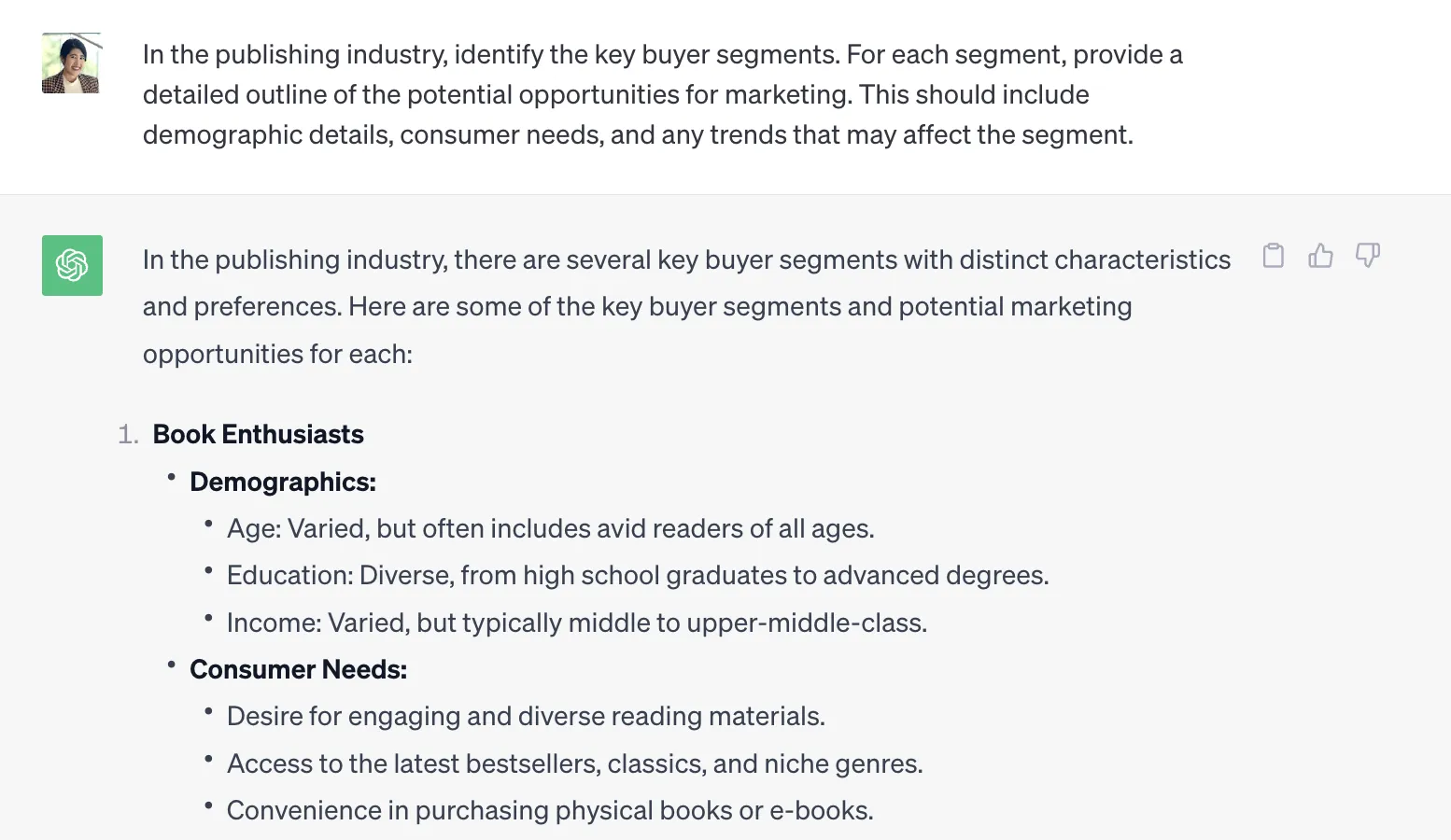
Identify the common challenges faced by the specified buyer persona. These challenges can range from daily inconveniences to major obstacles that influence their buying decisions.
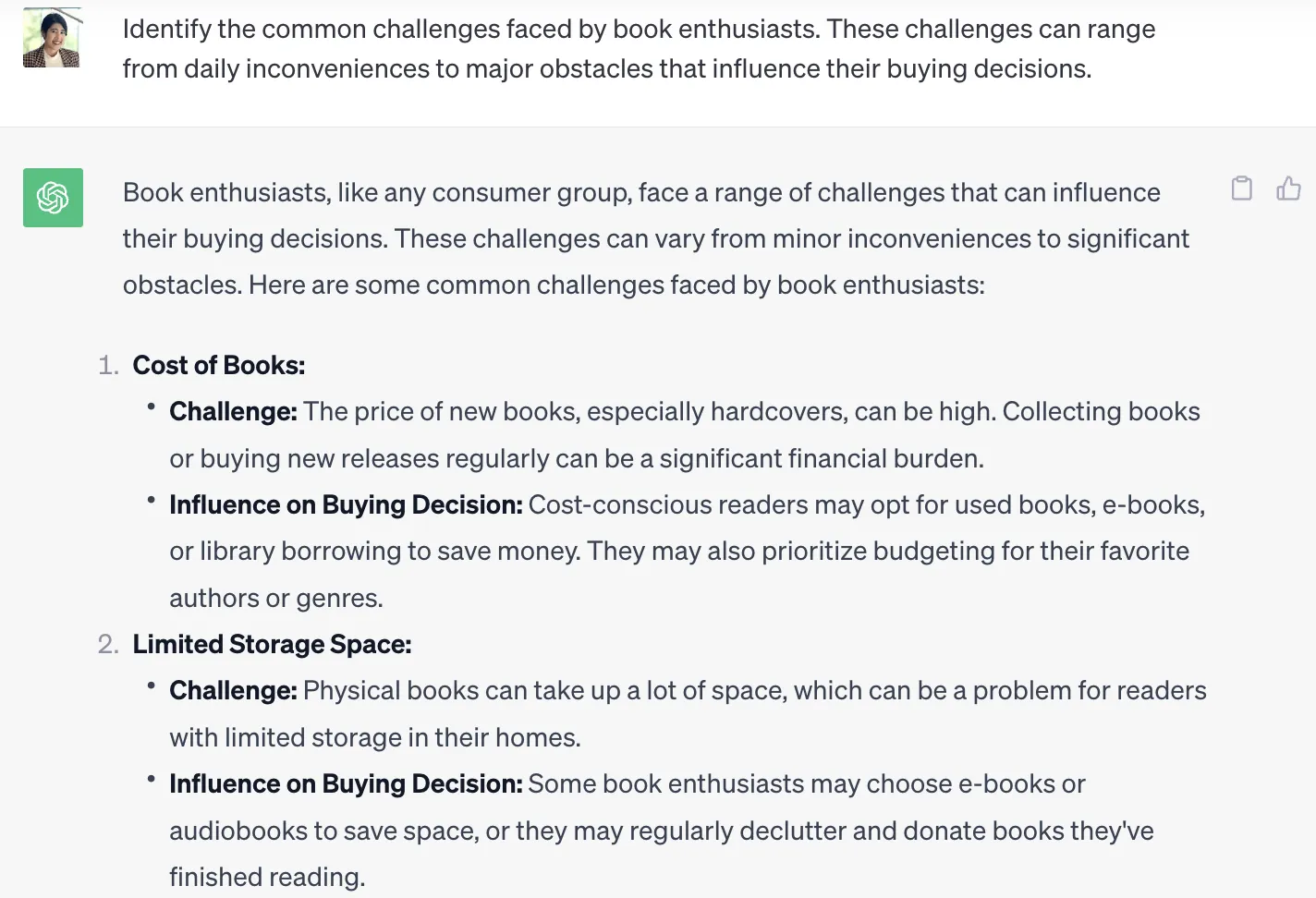
Suggest email copy and design ideas to run a campaign for [occasion]. Stick to our brand guidelines and come up with intriguing ideas based on some pop-culture themes.
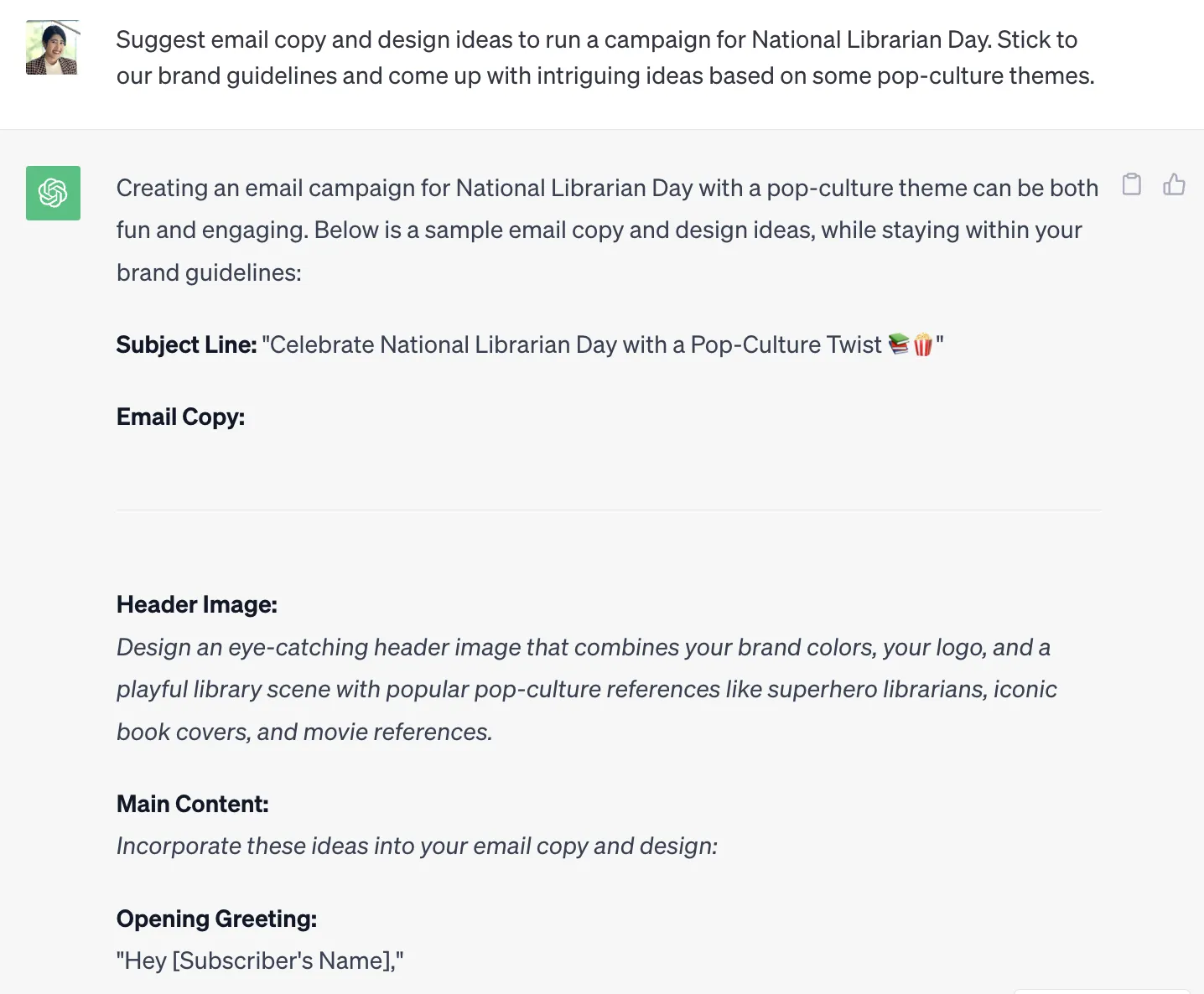
Here’s some text from a blog post about books: [add text]. Modify it to fit the character limit of [social platform]. Make sure to keep the main message and tonality intact, but feel free to use abbreviations and X-specific language.
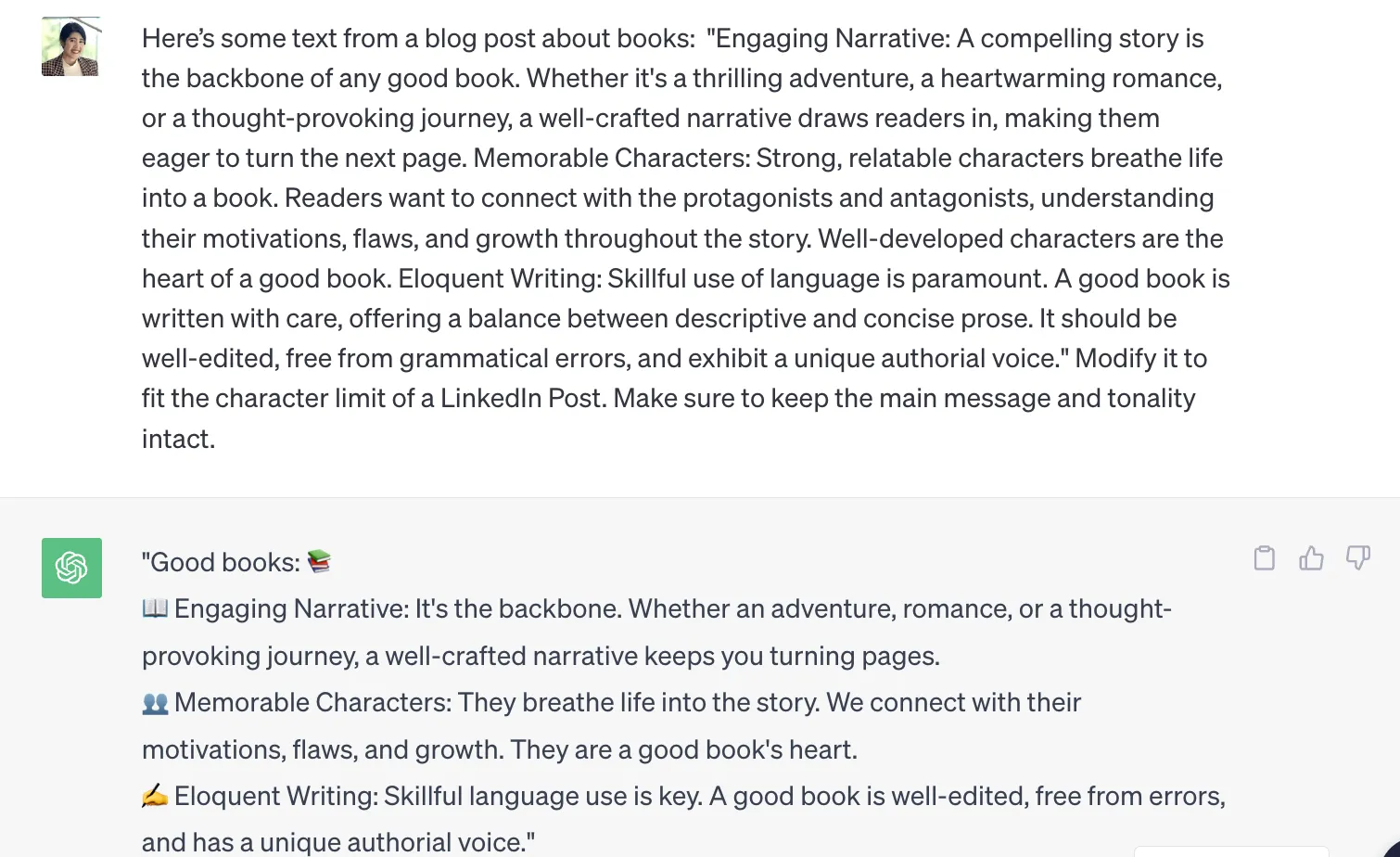
Generate five different descriptions for our YouTube video on [topic]. Each description should be engaging and accurately reflect the content of the video. Optimize it for [keyword]. Keep the tone conversational and exciting.
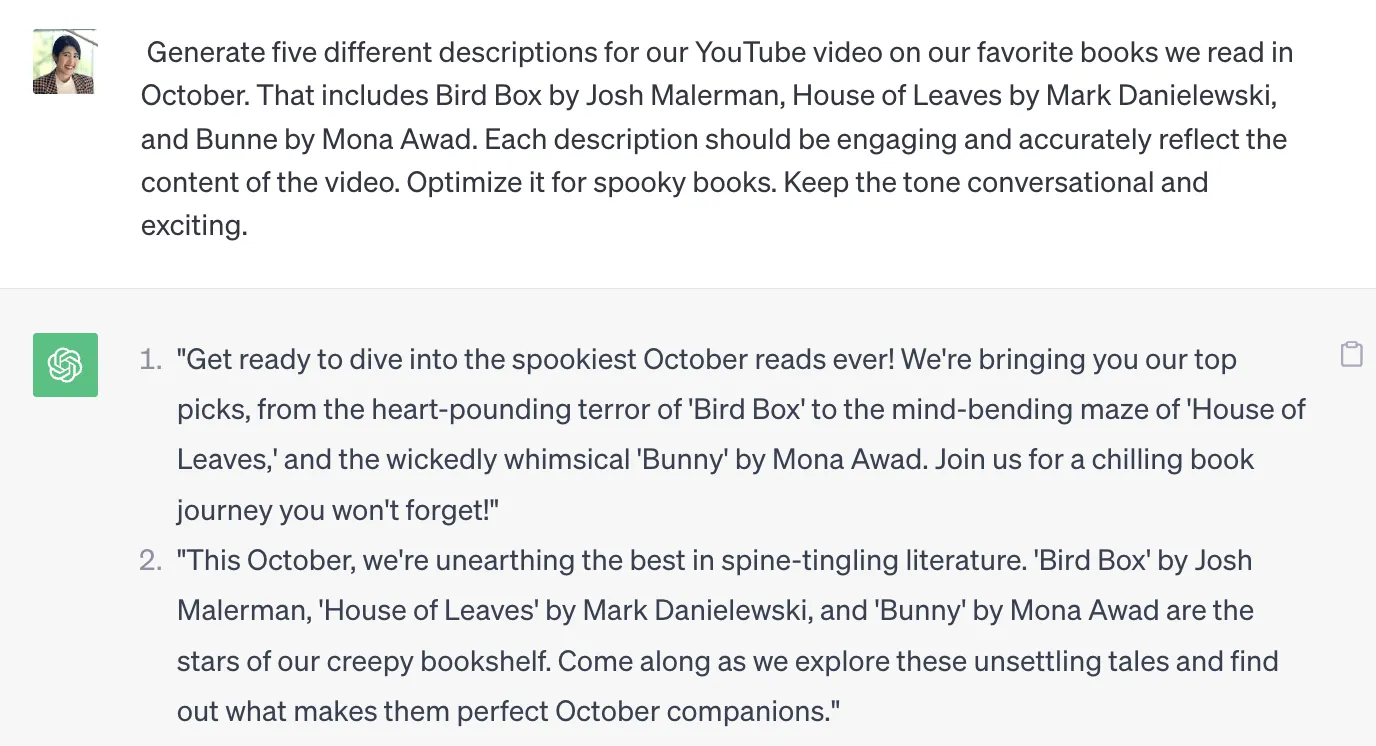
Write a title tag and meta description for the blog post about [subject]. The title tag should be attention-grabbing, and the meta description should provide a brief summary of the blog post.
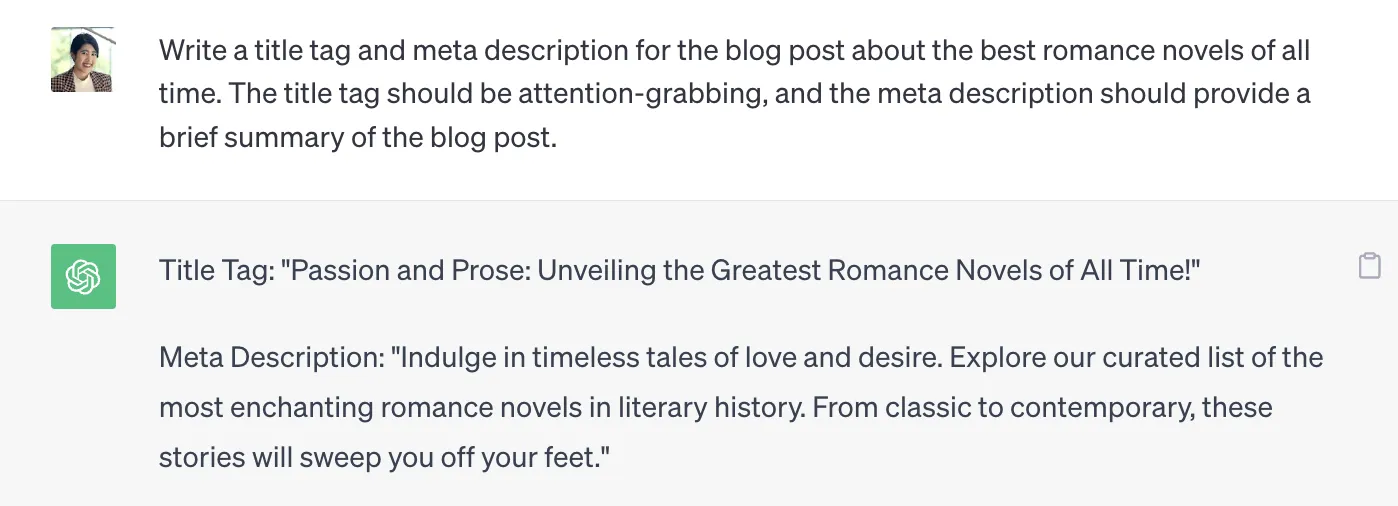
We want to conduct a webinar for our target audience: [specify personas]. Come up with 5-6 creative ideas for this webinar that would resonate with our audience. Align these with their pain points and our product/service. Add a basic overview with specific subtopics to cover.
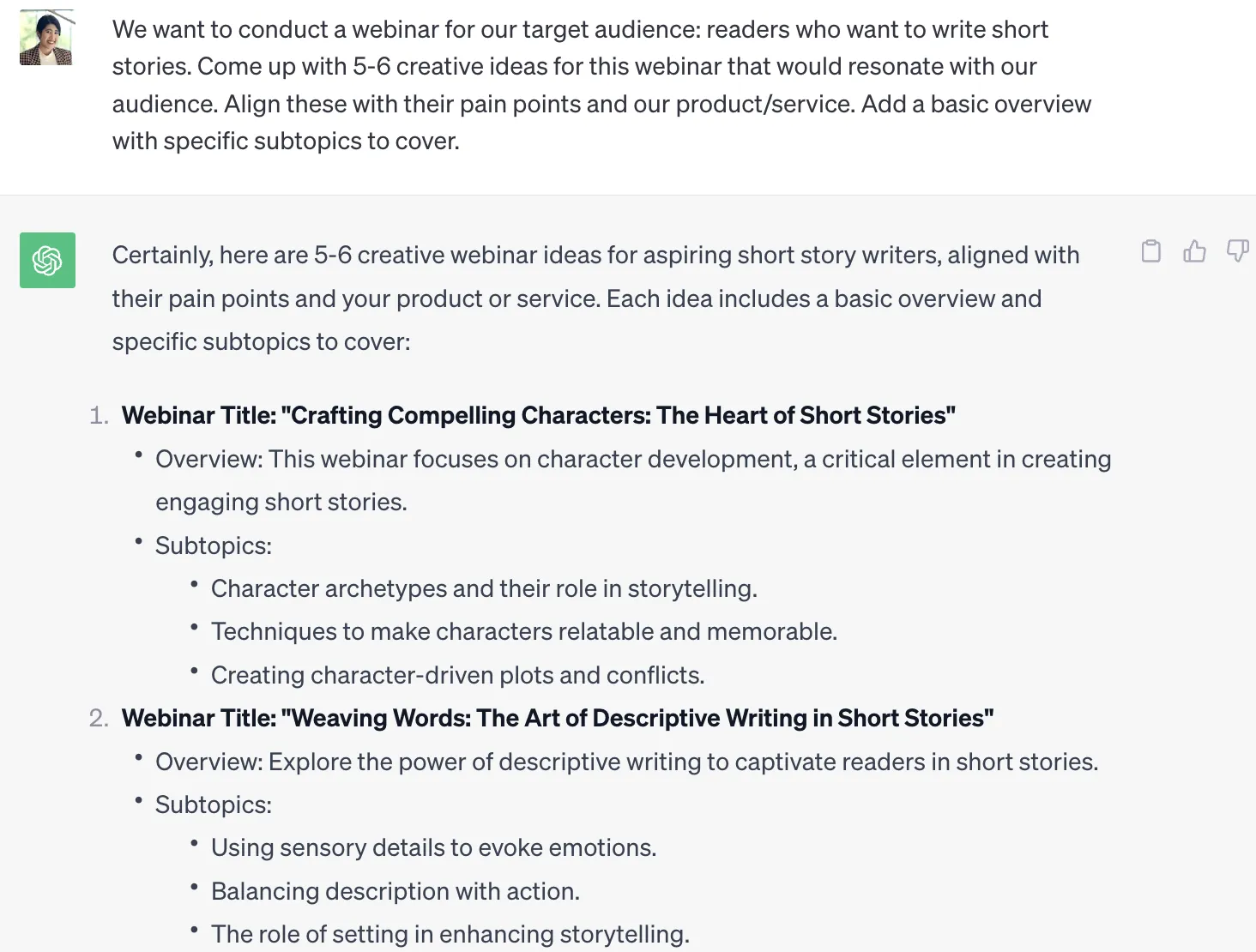
Provide a list of reliable sources where I can learn more about [topic]. These can include books, articles, newsletters, thought leaders, or educational videos.
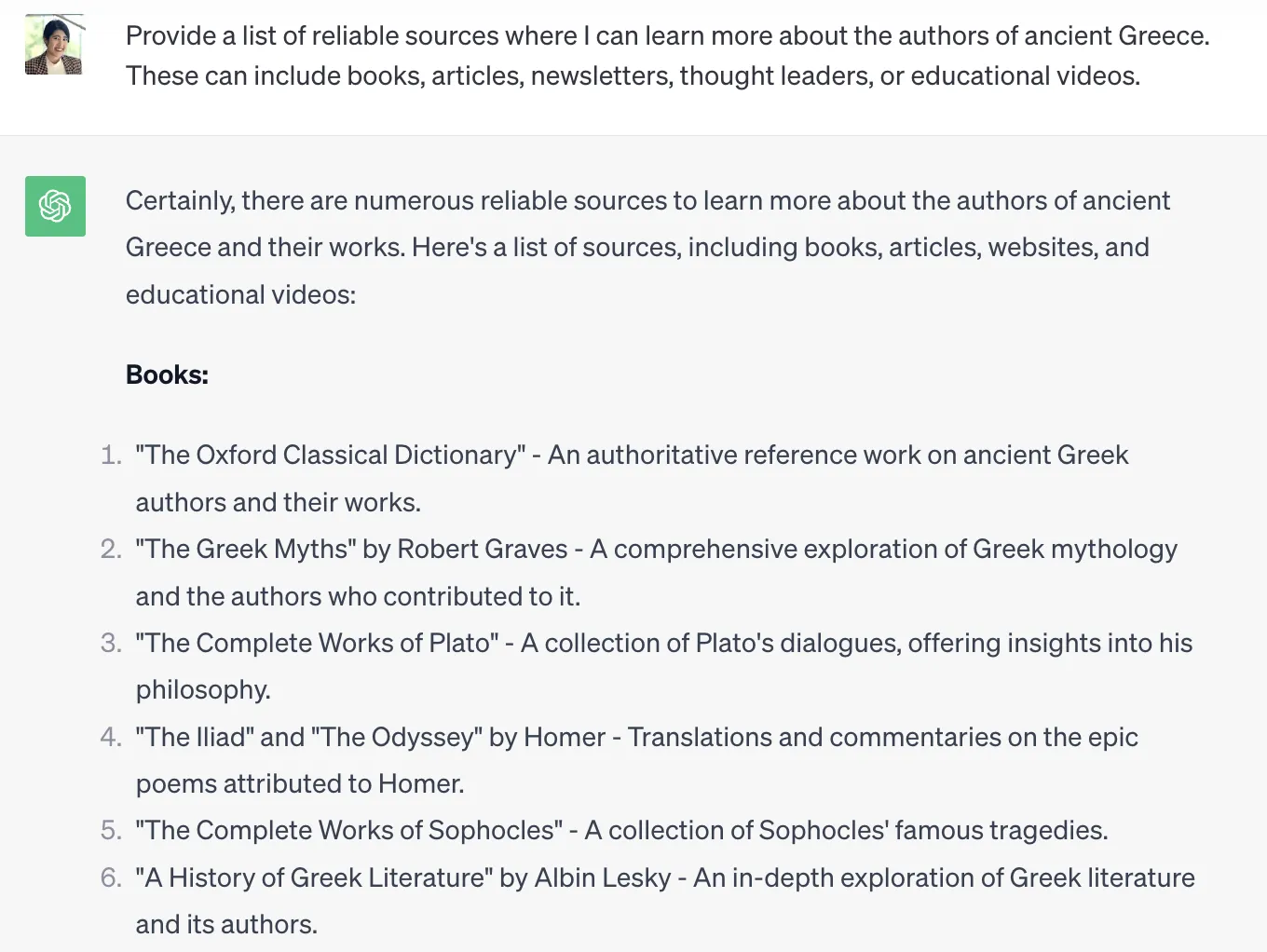
Review this blog post (enter inserted text) and check for any spelling or grammar mistakes. Make the necessary edits to improve the text for readability, the flow of ideas, redundancies, logical arguments, and contextual relevance.

Create five memes around the idea of [explain your idea]. Make these memes relatable for [target audience] and suggest captions to make them more hilarious.
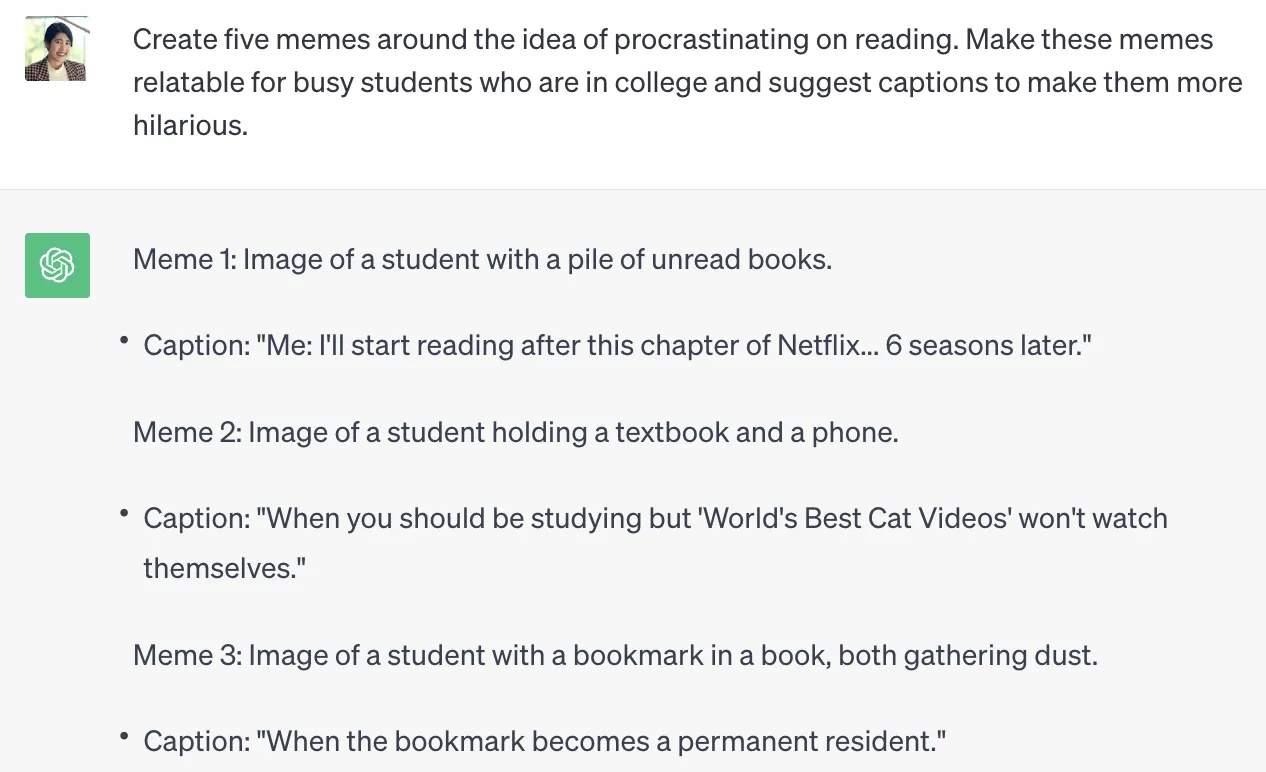
Here’s your step-by-step guide to training your ChatGPT to produce tailored output for your needs:
Check if you have Python 3.0+ installed. You need Python 3.0+ to train ChatGPT with custom data.
You can check which version of Python or whether Python is installed on your MacOS Terminal using the command:
|
python3 --version |
If not, download the latest version of Python from the official website.
PIP (standard package manager for Python) lets you install Python libraries. In our case, we need to install OpenAI, PyPDF2, and other libraries.
PIP comes pre-packaged with new Python versions. However, if you’re using an old installation, upgrade PIP to the latest version.
Here’s the command to upgrade PIP:
|
python3 -m pip install -U pip |
The next step is to install the following essential libraries (use the commands mentioned below their description to install them one-by-one):
|
pip3 install openai |
|
pip3 install PyPDF2 |
|
pip3 install gpt_index |
|
pip3 install gradio |
Now, we’re done installing the essential Python libraries.
Before we head over to the next step, make sure you have installed a code editor like Sublime Text or Notepad++.
Step 4. Generate your OpenAI key.When you’re done with the setup, log into your OpenAI account (or create a new one).
This is the same account you’re using to access ChatGPT.
You'll get three options for logging in. Choose the API option to get started.
Once you’re in, navigate to the top-right corner of your screen and click on Personal to open a drop-down menu with these options.
Here, you have to click on View API keys.
Click on Create a new secret key to generate a new API key and give it a name.
Then, you'll get a key. Copy and paste it into a code editor.
Now, you have to create a folder named ‘docs’ on your system.
Add all documents you want to use for training ChatGPT. These documents have to be in the TXT, PDF, CSV, or SQL formats.
Note: The more files you add for ChatGPT to feed, the more tokens will be used.
Step 6. Create the script.Now we have everything in place.
In this step, we’ll create a Python script to train ChatGPT with your custom data.
This script will use the files inside the ‘docs’ folder we created in the previous step and generate a .json file.
Open your code editor and paste the following code into a file.
|
from gpt_index import SimpleDirectoryReader, GPTListIndex, GPTSimpleVectorIndex, LLMPredictor, PromptHelper from langchain import OpenAI import gradio as gr import sys import os os.environ[“OPENAI_API_KEY”] = ‘ ’ def construct_index(directory_path): max_input_size = 4096 num_outputs = 512 max_chunk_overlap = 20 chunk_size_limit = 600 prompt_helper = PromptHelper(max_input_size, num_outputs, max_chunk_overlap, chunk_size_limit=chunk_size_limit) llm_predictor = LLMPredictor(llm=OpenAI(temperature=0.7, model_name=“text-davinci-003”, max_tokens=num_outputs)) .. |